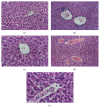Resveratrol and Montelukast Alleviate Paraquat-Induced Hepatic Injury in Mice: Modulation of Oxidative Stress, Inflammation, and Apoptosis
- PMID: 29201275
- PMCID: PMC5671749
- DOI: 10.1155/2017/9396425
Resveratrol and Montelukast Alleviate Paraquat-Induced Hepatic Injury in Mice: Modulation of Oxidative Stress, Inflammation, and Apoptosis
Abstract
Paraquat (PQ) is one of the most used herbicide worldwide. Its cytotoxicity is attributed to reactive radical generation. Resveratrol (Res) and montelukast (MK) have anti-inflammatory and antioxidant properties. The protective effects of Res, MK, or their combination against PQ-induced acute liver injury have not been investigated before. Therefore, we explored the protective potential of Res and/or MK against PQ hepatic toxicity in a mouse model. Mice were randomly assigned to five groups: group I served as the normal control and group II received a single dose of PQ (50 mg/kg, i.p.). Groups III, IV, and V received PQ plus oral Res (5 mg/kg/day), MK (10 mg/kg/day), and Res/MK combination, respectively. Res and/or MK reduced PQ-induced liver injury, evidenced by normalization of serum total protein, ALT, and AST. Res and/or MK significantly reversed PQ-induced oxidative stress markers glutathione and malondialdehyde. Res and/or MK significantly reduced PQ-induced inflammation reflected in TNF-α levels. Furthermore, Res and/or MK reversed PQ-induced apoptosis assessed by differential expression of p53, Bax, and Bcl-2. Histopathologic examination supported the biochemical findings. Although Res and MK displayed antioxidative, anti-inflammatory, and antiapoptotic activities, their combination was not always synergistic.
Figures




Similar articles
-
Artificial sweetener neohesperidin dihydrochalcone showed antioxidative, anti-inflammatory and anti-apoptosis effects against paraquat-induced liver injury in mice.Int Immunopharmacol. 2015 Dec;29(2):722-729. doi: 10.1016/j.intimp.2015.09.003. Epub 2015 Sep 9. Int Immunopharmacol. 2015. PMID: 26362205
-
Porous Se@SiO2 nanospheres treated paraquat-induced acute lung injury by resisting oxidative stress.Int J Nanomedicine. 2017 Sep 27;12:7143-7152. doi: 10.2147/IJN.S143192. eCollection 2017. Int J Nanomedicine. 2017. PMID: 29026307 Free PMC article.
-
Protective Effects of Apigenin Against Paraquat-Induced Acute Lung Injury in Mice.Inflammation. 2016 Apr;39(2):752-8. doi: 10.1007/s10753-015-0302-2. Inflammation. 2016. PMID: 26782361
-
Hepatoprotective and therapeutic effects of resveratrol: A focus on anti-inflammatory and antioxidative activities.Fundam Clin Pharmacol. 2022 Jun;36(3):468-485. doi: 10.1111/fcp.12746. Epub 2022 Jan 17. Fundam Clin Pharmacol. 2022. PMID: 34935193 Review.
-
[The efficacy of traditional Chinese medicin in animal model of lung injury induced by paraquat: a meta-analysis].Zhonghua Wei Zhong Bing Ji Jiu Yi Xue. 2014 Jun;26(6):399-404. doi: 10.3760/cma.j.issn.2095-4352.2014.06.007. Zhonghua Wei Zhong Bing Ji Jiu Yi Xue. 2014. PMID: 24912638 Chinese.
Cited by
-
Comparison of Pancreatic Damage in Rats for Two Methods of Paraquat Administration.Front Pharmacol. 2021 Apr 20;12:611433. doi: 10.3389/fphar.2021.611433. eCollection 2021. Front Pharmacol. 2021. PMID: 33967752 Free PMC article.
-
Montelukast, an available and safe anti-asthmatic drug, prevents maladaptive remodelling and maintains cardiac functionality following myocardial infarction.Sci Rep. 2024 Feb 9;14(1):3371. doi: 10.1038/s41598-024-53936-x. Sci Rep. 2024. PMID: 38337010 Free PMC article.
-
Investigation of Montelukast Effect on Rosuvastatin Induced Late Puberty in Rats.J Hum Reprod Sci. 2022 Jul-Sep;15(3):228-232. doi: 10.4103/jhrs.jhrs_56_22. Epub 2022 Sep 30. J Hum Reprod Sci. 2022. PMID: 36341010 Free PMC article.
-
Synergistic impacts of Montelukast and Klotho against doxorubicin-induced cardiac toxicity in Rats.Toxicol Res (Camb). 2022 Jun 20;11(4):592-604. doi: 10.1093/toxres/tfac023. eCollection 2022 Aug. Toxicol Res (Camb). 2022. PMID: 36051669 Free PMC article.
-
Dose-response effect of Montelukast on post-extraction dental socket repair and skeletal phenotype of mice.Odontology. 2023 Oct;111(4):891-903. doi: 10.1007/s10266-023-00800-5. Epub 2023 Mar 15. Odontology. 2023. PMID: 36920595
References
-
- Lattuca M. E., Malanga G., Aguilar Hurtado C., Perez A. F., Calvo J., Puntarulo S. Main features of the oxidative metabolism in gills and liver of Odontesthes nigricans Richardson (Pisces, Atherinopsidae) Comparative Biochemistry and Physiology. Part B, Biochemistry & Molecular Biology. 2009;154:406–411. doi: 10.1016/j.cbpb.2009.08.004. - DOI - PubMed
-
- Malekinejad H., Rahmani F., Hassanpour F. Influences of sub-acute exposure to paraquat on cytochrome P450 3A2 expression in rat liver and lungs. Pesticide Biochemistry and Physiology. 2010;96:149–154. doi: 10.1016/j.pestbp.2009.11.003. - DOI
MeSH terms
Substances
LinkOut - more resources
Full Text Sources
Other Literature Sources
Research Materials
Miscellaneous

